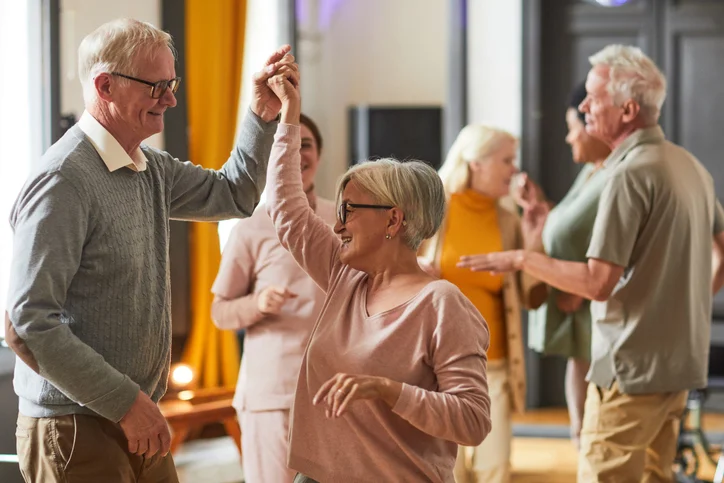How is your social life? Social health is a fundamental part of our overall wellness, yet it is often overlooked in health-related discussions. Studies show that strong social connections contribute to longer lifespans, improved mental well-being, and a higher quality of life for seniors. Conversely, loneliness in seniors can have serious health consequences, increasing the risk of depression, cognitive decline, and even premature mortality.
For many older adults, the choice between staying in one’s traditional family home or transitioning to an active retirement community significantly impacts their social wellness. While living at home may offer familiarity, it often leads to isolation. In contrast, senior communities provide built-in opportunities for engagement, fostering a vibrant and connected lifestyle. This article explores the differences in social health between these two living arrangements and highlights the benefits of senior living communities.
Exploring the Struggle of Social Isolation at Home
Despite the comfort of home, many older adults face increasing social isolation. According to AARP, more than one-third of adults over 45 feel lonely. The National Institute on Aging warns that social isolation can increase health risks comparable to obesity and smoking. Seniors living alone may experience dwindling social connections, leading to a decline in mental and physical health.
What Causes Social Isolation?
Several factors contribute to social isolation for older adults:
- Reduced mobility and transportation issues: Limited access to senior transportation can make attending social activities or running errands challenging.
- Loss of a spouse or close friends: As friends and loved ones pass away, older adults may struggle to maintain a strong support system.
- Decreased opportunities for spontaneous social interaction: Without structured activities, seniors may go days or even weeks without meaningful engagement.
- Challenges in maintaining a home and social engagements: The demands of home upkeep can drain energy and motivation for socializing.
The Impact of Social Isolation on Overall Well-Being
The effects of social isolation extend beyond loneliness. Research from the National Academies of Sciences, Engineering, and Medicine reveals that prolonged isolation increases the risk of:
- Depression and anxiety, leading to a diminished sense of purpose.
- Cognitive decline, including a heightened risk of dementia.
- Weakened immune function, making seniors more vulnerable to illness.
- Lower quality of life, with fewer opportunities for joy and fulfillment.
- Increased mortality rates, with some studies equating the effects of isolation to smoking 15 cigarettes a day.
Thriving in Community: The Social Advantages of Senior Living
Senior living communities are designed to promote an enriching social lifestyle. With structured social activities for seniors and a built-in support network, residents can maintain an active and engaged retirement lifestyle.
Peer Support and Built-in Community
A key benefit of senior communities is the ability to easily form friendships. Shared experiences and common interests help foster a strong sense of belonging. Residents find companionship, emotional support, and a vibrant social life that enhances their overall happiness.
Communal Dining and Social Meals
Mealtime is a vital social opportunity. Unlike seniors living alone who may eat in isolation, community dining fosters conversation, connection, and even new friendships. Sharing meals enhances the overall dining experience and provides daily interaction that improves well-being.
Access to Social Spaces and Amenities
Senior communities offer inviting spaces that encourage social engagement, such as:
- Lounges and libraries, perfect for casual conversations or reading groups.
- Activity rooms and game areas, where residents can engage in friendly competition.
- Fitness centers and outdoor spaces, promoting both physical and social wellness for seniors.
Transportation and Organized Outings
A major advantage of senior communities is access to scheduled outings and reliable transportation. Whether it’s shopping, attending cultural events, or social outings for seniors, transportation services eliminate barriers to staying engaged.
Volunteerism, Mentorship, and Community Contributions
Staying active in meaningful ways is an essential part of retirement activities. Many senior communities offer volunteer opportunities, allowing residents to give back, mentor, and remain involved in causes that matter to them. Engaging in these activities provides a deep sense of purpose and fulfillment.
Community Living: Common Concerns and Misconceptions
Despite the clear benefits of senior living communities, some older adults hesitate due to misconceptions:
- Fear of losing independence: In reality, senior communities enhance independence by removing home maintenance burdens and offering support only when needed.
- Concerns about fitting in: Senior communities are diverse, offering various activities and interest groups to suit different personalities and lifestyles.
- Financial worries: While some fear the cost, senior living can often be more cost-effective when factoring in home upkeep, healthcare, and lifestyle amenities.
Embrace a Socially Rich Future at The Waterford
Social wellness for seniors is crucial for overall health, happiness, and longevity. While aging in a familiar family home may feel comforting in the short term, it often leads to increased isolation and declining health. Active retirement communities provide a dynamic, connected, and engaging lifestyle, making it easier to form friendships, participate in senior activities, and enjoy a fulfilling social life.
If you or a loved one are considering retirement living options, we invite you to explore the exceptional opportunities at The Waterford. Schedule a tour today to discover how community living can enhance your well-being and enrich your social life.


